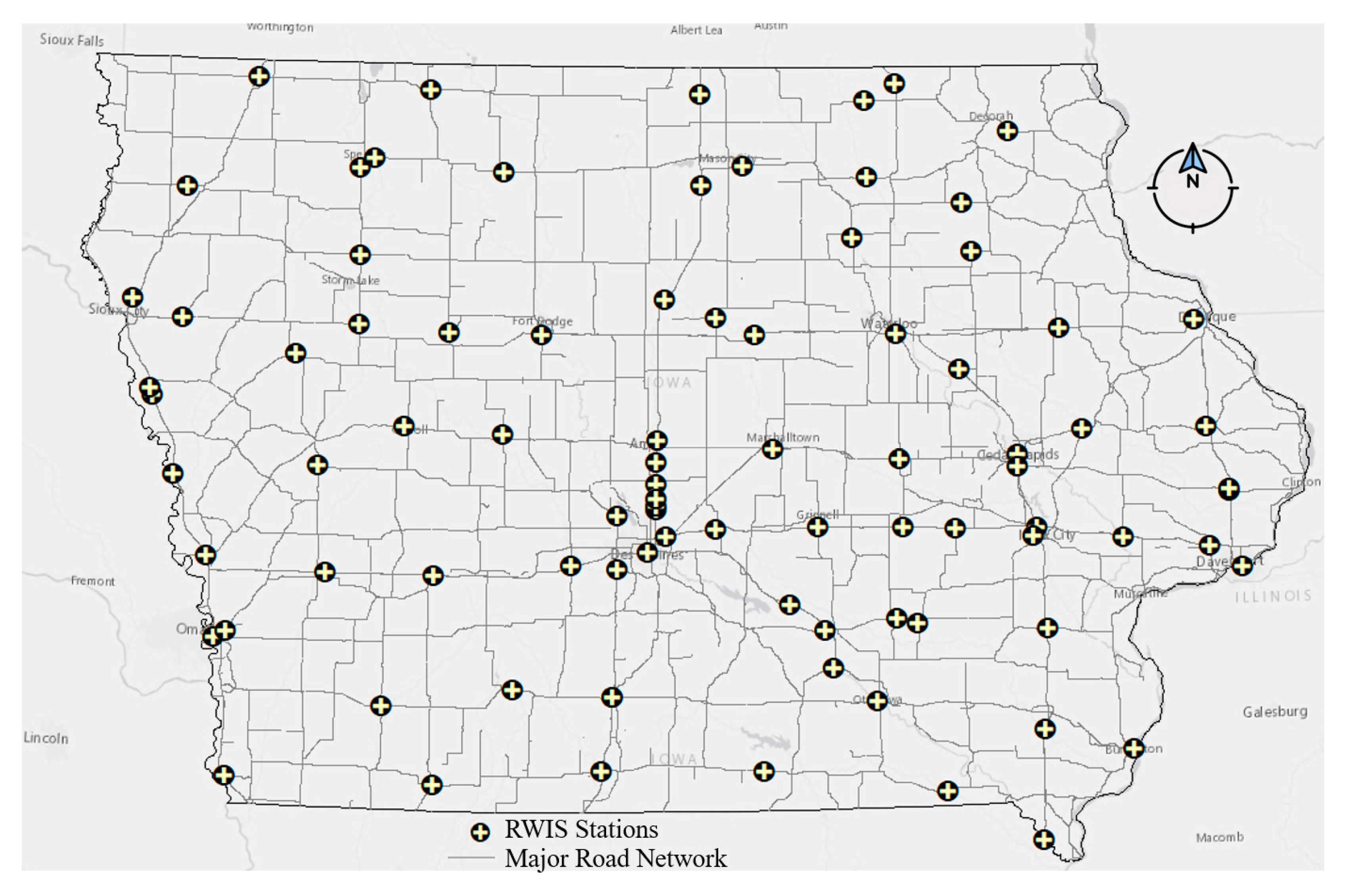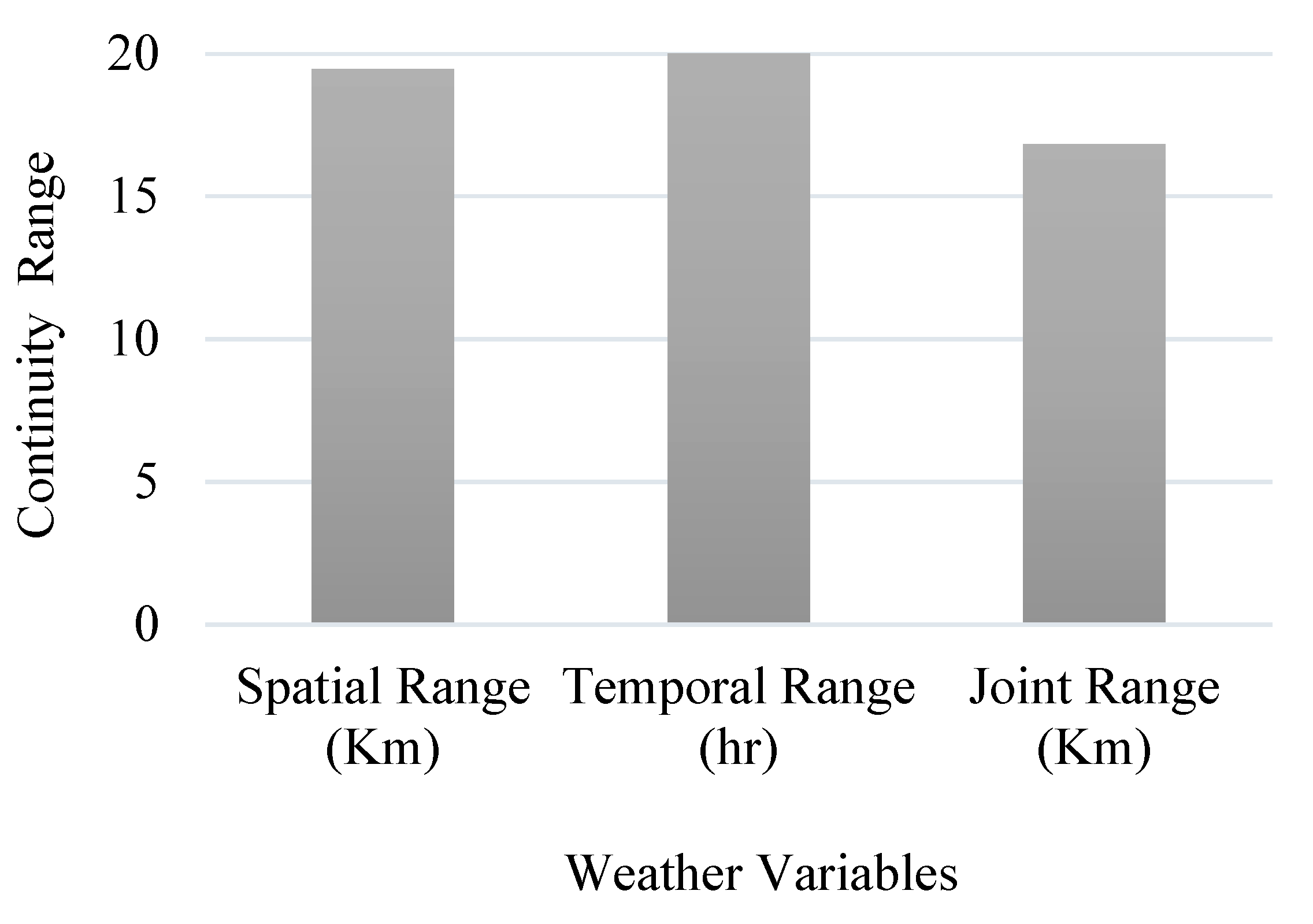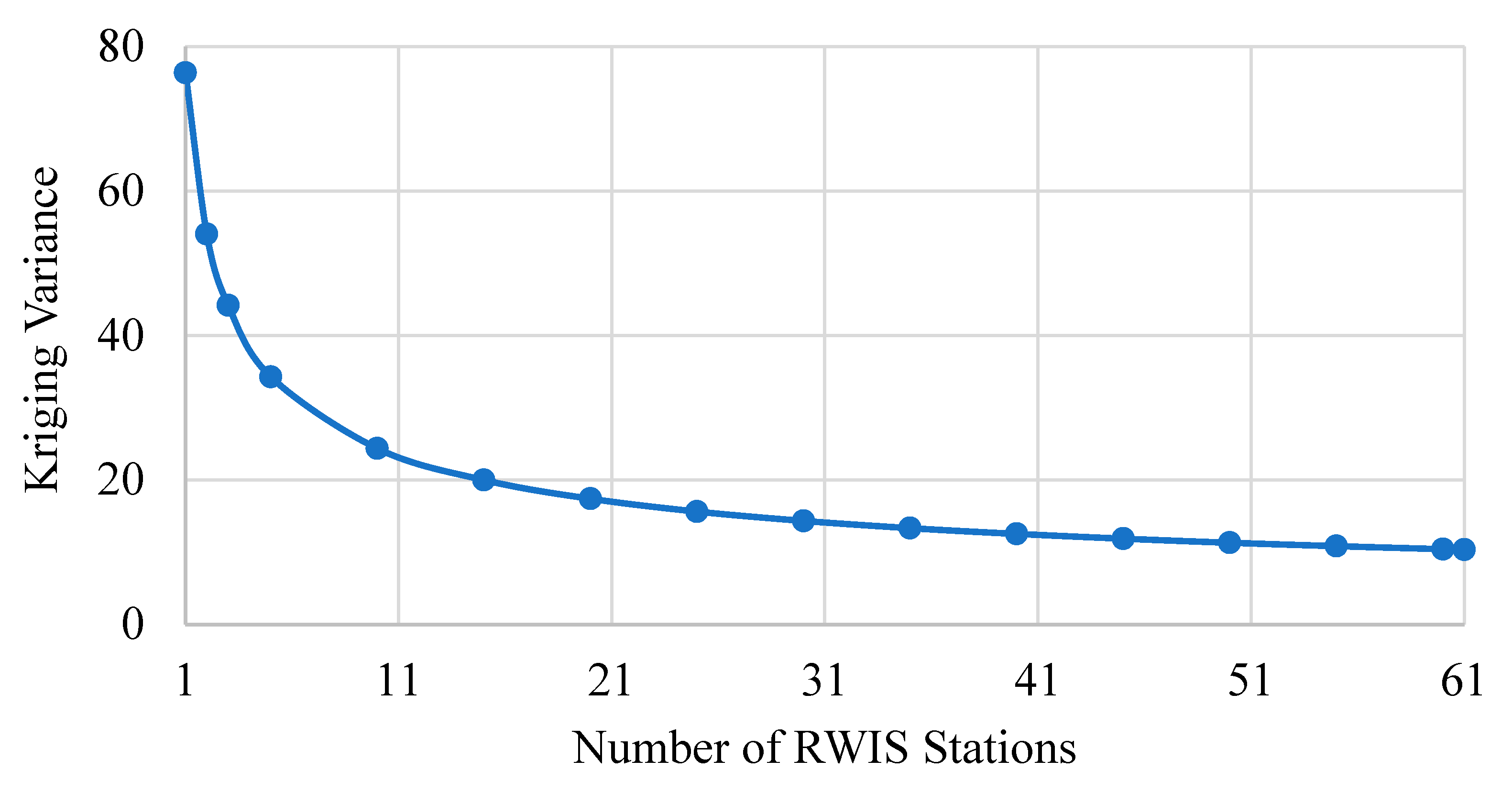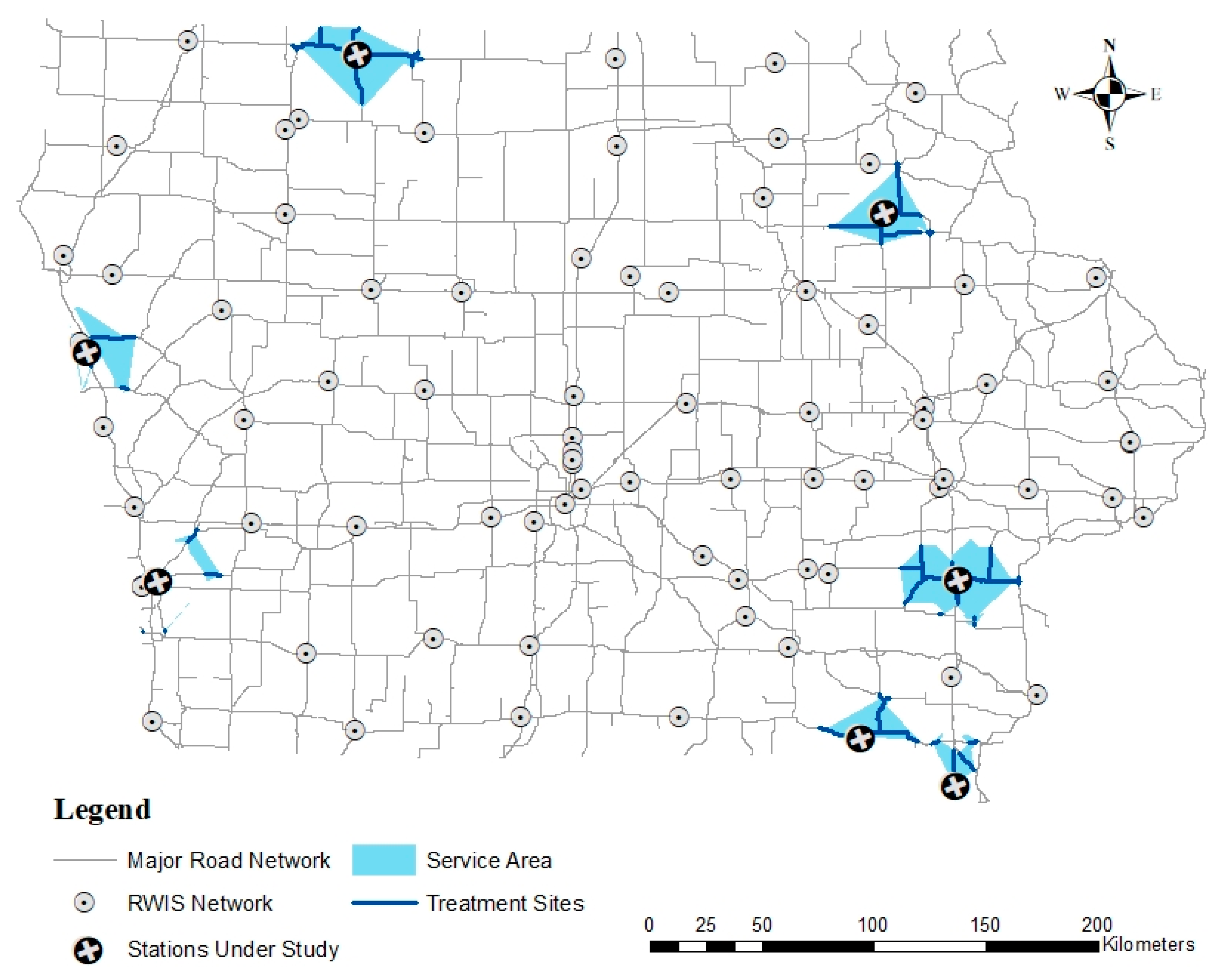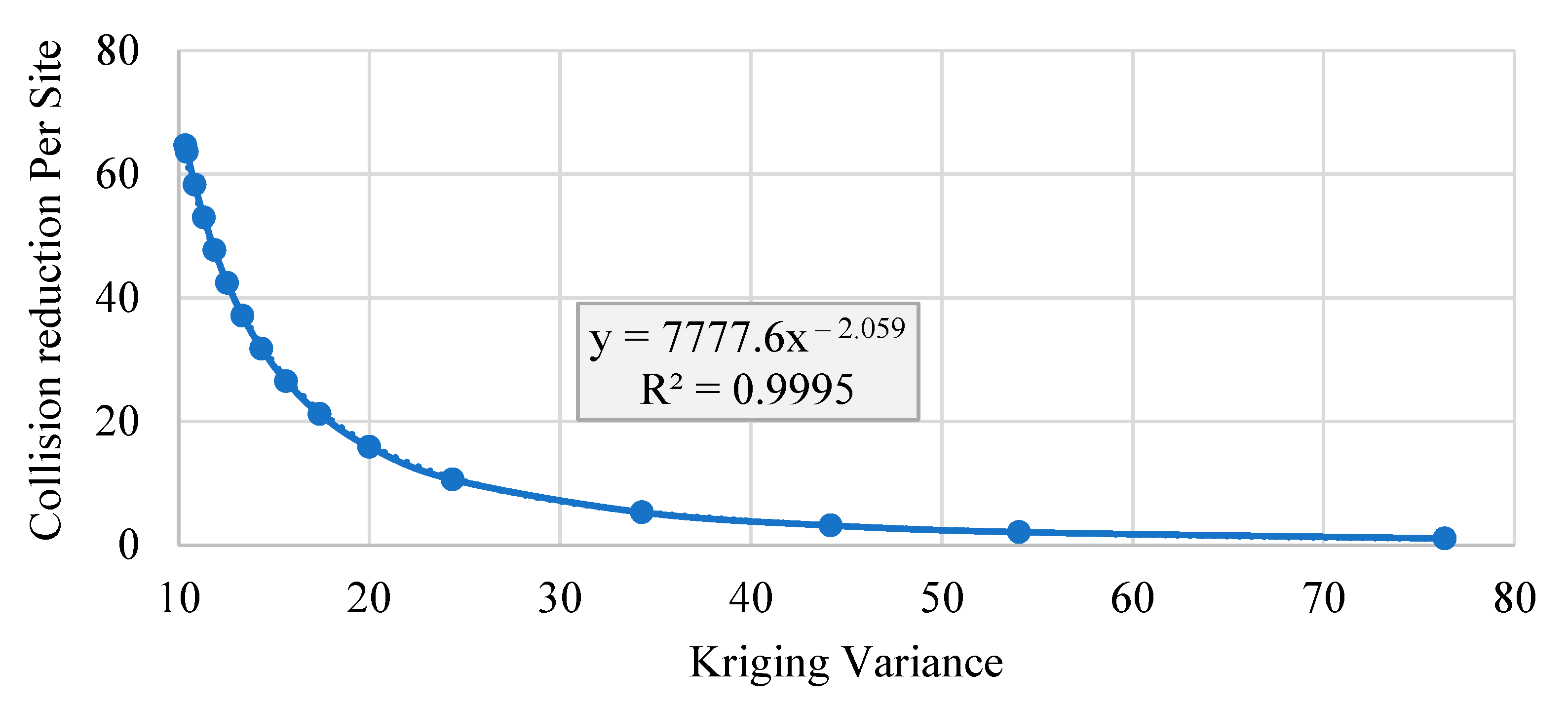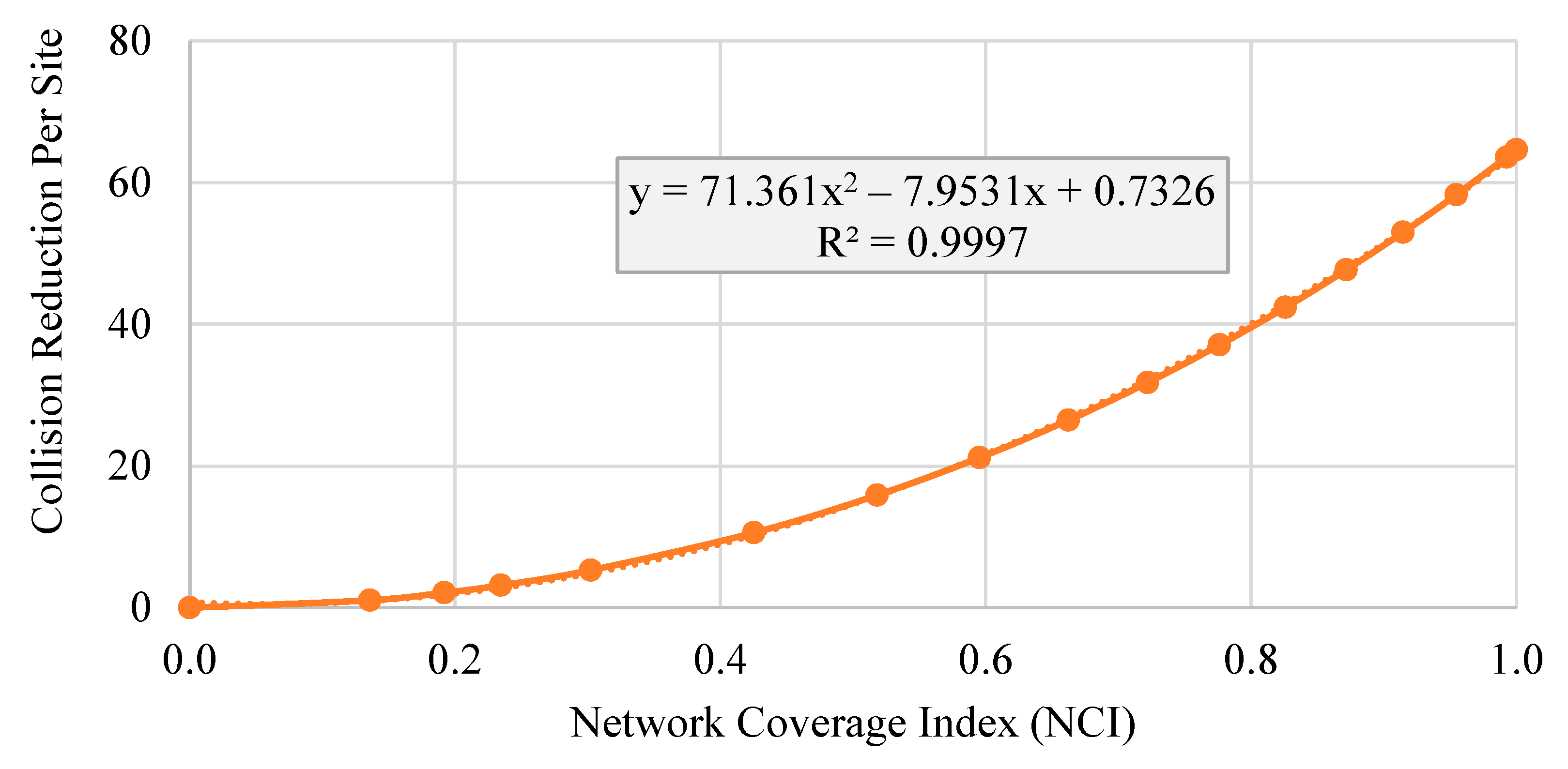1. Introduction and Background
According to a recent study by the Federal Highway Administration (FHWA), adverse weather condition causes about 21% of all road collisions every year in the U.S. [
1]. Statistics shows that, over 1.5 million road accidents, 0.8 million injuries, and 7000 fatalities occur annually in the U.S. due to adverse weather [
2]. In its northern neighbor—Canada, every year, about 3000 deaths result from weather-related road crashes, and over 1 in 135 people experience driving-related injuries [
3]. According to the Ontario Road Safety Annual Reports, poor road surface condition leads to 17 percent increase in vehicle crashes over the last 16 years [
4]. As a result, winter-related road incidents have become a significant concern for many jurisdictions. Among many strategies that exist to meet this objective, one approach is to provide better road conditions through more efficient maintenance operations. This method would require maintenance personnel to thoroughly understand both weather and road conditions on their road network, which can be done through one of the most critical pieces of highway intelligent transportation systems (ITS) infrastructure called Road Weather Information Systems (RWIS).
RWIS consist of a group of sensors that monitors road weather and surface conditions along the road network. Information regarding the road weather and surface condition are collected, processed and disseminated by the collaboration of advanced sensors. The collected information is used by road maintenance authorities to make timely operative decisions aimed at improving traffic safety and mobility before, during, and after inclement weather events. Additionally, RWIS provides travelers with better information via RWIS-connected dynamic message signs to help them make more informed travel decisions, which can reduce weather-related crashes and injuries [
5,
6]. Despite their usefulness and numerous benefits, a few limitations associated with RWIS stations have been identified thereby hindering their distribution. The most significant limitation is the installation cost. Depending on the type and number of sensors equipped, the cost could be as high as
$100,000 U.S. dollars per station [
7,
8]. Considering the limited budget for RWIS deployment and the random nature of road weather fluctuations, RWIS stations must be implemented strategically to ensure optimal monitoring coverage under varying circumstances to ensure both mobility and safety.
Due to the importance of RWIS infrastructure, numerous studies have been conducted to establish a siting guideline for RWIS installation. An extensive research was conducted by the U.S. Federal Highway Administration (FHWA) in 2005, where they analyzed existing information and conducted interviews with several state Department of Transportations (DOTs). According to this study, based on the knowledge and experience of field operators, 30 to 50 km (20 to 30 miles) of spacing is recommended between RWIS stations [
8]. As the recommended guidelines were based on experts’ opinion and prior experiences, several researches were conducted to identify a more systematic way to quantify the spatial coverage of RWIS data and optimal placement of RWIS stations [
2,
9,
10,
11,
12,
13].
In a GIS-based study conducted by Kwon and Fu (2013), a framework for RWIS network location evaluation was presented, where the variability of the surface temperature (VST), mean surface temperature (MST), and snow water equivalent (SWE) were considered alongside topographical location attributes. The output of this study revealed the feasibility of developing a systematic process for RWIS installation using an integrated location criterion by capturing multiple variables [
14]. Similarly, in a more recent study conducted by Kwon et al. (2017), RWIS network location optimization was performed through an innovative geostatistical analysis technique—kriging. Optimization was formulated as a Nonlinear Integer Programming (NIP) problem to maximize the monitoring capability while minimizing the spatially averaged kriging variance of hazardous road surface conditions. The RWIS data used in this study were taken from the state of Minnesota, U.S., to evaluate the effectiveness of the current RWIS location setting and make recommendations for future network expansion. Although the method developed contributed to delineating RWIS locations, it only dealt with a spatial domain without considering inherent temporal variations of road weather parameters, making their location solutions less conclusive [
15]. Hence, Kwon and Fu (2017) further extended their previous work to investigate the dependency of optimal RWIS spacing of a region on the spatiotemporal variability of road weather conditions and corresponding topographical characteristics of the region. A group of case studies were conducted by the authors using data from three U.S. states (Iowa, Utah, and Minnesota) and one Canadian province (Ontario) [
16]. Although the output of this research entails that the number of RWIS stations required for a region would depend on the topographic settings, they did not provide a systematic method for regions with limited or no RWIS information.
Considering the resurgent need to build a systematic and generalized RWIS network planning guideline, our previous efforts have developed a comprehensive and transferable methodological framework to optimize the design of a regional RWIS network by incorporating the use of multiple RWIS variables for improved spatiotemporal inference [
17,
18,
19]. Two crucial network planning questions were answered through that research: (i) how many RWIS stations are needed in a region with varying environments to provide sufficient coverage over space and time? And (ii) where should these stations be located to provide adequate monitoring coverage of a given region? In other words, the optimal density and location of RWIS stations were determined to provide the maximum monitoring coverage for a region. During the problem formulation, it was assumed that the optimal RWIS network provides the maximum coverage of the region under investigation. Geostatistical approaches were implemented to determine the optimum number of RWIS stations across several topographic and weather zones covering 14 U.S. States. In the subsequent step, a methodological framework was developed to determine the optimal RWIS locations by considering the spatiotemporal characteristics of critical RWIS variables.
Although the generalized guideline developed in our previous studies provides a solid foundation for RWIS network planning, no prior efforts have been made to examine and quantify the benefits of an optimally situated RWIS network. While developing the optimal RWIS location solution, it was implicitly assumed that each solution set is associated with a unique spatial configuration tied to an objective function value or sum of kriging variance that represents RWIS’ monitoring capability. The solution set associated with the lowest objective function value (lowest kriging variance) would be considered the solution with the highest network coverage and thus assumed to be most beneficial [
19]. Based on this presumption that network coverage is a vital parameter for determining the goodness of an RWIS configuration, there is a resurgent need to extend this effort by investigating if it could also be used to explain its impact on traffic safety—a worthwhile attempt that has never been made in existing literature pertaining to quantifying the safety benefits of RWIS location solutions.
Therefore, the primary objectives of this study are: (a) to investigate the relationship between a newly created measure called network coverage index (NCI) and network configuration of RWIS, and (b) quantitatively assess the impact of NCI on the transportation system based on collision reduction potential. The findings of this research will provide a clearer understanding of the benefit of an optimal RWIS solution and its impact on the transportation system.
The remainder of the paper is organized as follows. The next section presents the methodological approach used to meet the research objective, followed by a description of the study area and data used. Next, the results obtained are analyzed in detail with discussion. This is succeeded by the
Section 5, which highlights the key findings and provides recommendations for future research.
2. Methodology
2.1. Overview of Research Procedures
The first phase of this study was the database development by aggregating and integrating various data sets into GIS. Two datasets were developed, one to determine the NCI (a more detailed description is to follow) and another to evaluate safety.
After extracting the RWIS station data, a quality check was performed using the following steps: data completeness test, reasonable range test, and a neighborhood value comparison. Following this, detrending was performed with respect to time using Generalized additive model (GAM) [
20,
21], followed by geostatistical analysis. Spatiotemporal analysis was performed by constructing empirical semivariograms from the processed data, which optimizes parameter estimations for unsampled locations and captures the possible autocorrelation associated with the RWIS variables. Joint semivariogram models were then developed by combining spatial and temporal semivariograms to evaluate the spatiotemporal variability of RWIS measurements [
19]. Based on parameters obtained from the joint semivariogram, kriging interpolation was used to estimate values at unsampled locations and their estimation error or kriging variance. Kriging variance was then utilized to determine the
NCI for respective RWIS networks. The procedure was repeated for each set of RWIS configurations to investigate its impact on the
NCI.
In terms of safety evaluation, 12 years (2008 to 2019) of inclement winter weather collision data were extracted, among which collisions due to poor road surface conditions were isolated for safety evaluation. Additionally, only major network roads, i.e., Interstate, State, and U.S. highways were considered due to maintenance departments prioritizing major roads for treatment. RWIS stations included in the safety evaluation were selected based on three review criteria: (a) data review to ensure that sufficient before and after period collision data were available, (b) geometry review to ensure that no major design nor construction activities occurred near the RWIS stations, and (c) operation review to ensure that minimal operation gaps were present in the data. The processed data were employed to calibrate the safety performance functions (SPFs) and yearly calibration functions (YCFs). Next, Empirical Bayes (E.B.) analysis was applied to determine the collision reduction associated with each of the selected RWIS stations [
22].
Upon processing the data, the impact of
NCI on collision reduction was assessed in order to evaluate the goodness of the RWIS location solutions. Research procedures for this study are summarized in
Figure 1.
2.2. Determination of Network Coverage Index (NCI)
The network coverage index (NCI) was used to rate the monitoring capabilities of a defined RWIS configuration for a specific region. It is a surrogate measure that ranges between 0 and 1, where 0 represents no monitoring coverage, and 1 represents complete network coverage.
Determining
NCI requires the use of kriging, which is a widely used geostatistical technique that provides the best linear unbiased estimate (BLUE) for variables that vary over space [
23]. The weighted average of the observed data was used in kriging to predict values at unsampled locations, where the weights were determined based on the separation distance between the sampled points and unsampled locations. Kriging provides estimates at unknown locations along with estimation errors by quantifying the spatial variability over the area of interest [
24]. Ordinary Kriging (OK) is a form of kriging that assumes the mean to be unknown but constant over each local neighborhood [
24,
25]. OK estimation variance for an estimation location, x
0 can be defined by the following equation:
where,
G is the semivariance matrix between the observations and
g is the semivariance matrix between observations and unsampled points. The equations of
G and
g are given below:
Here, (i = 1, 2, …, k) is the sampling site of a sample subset of size k, where k = number of RWIS stations. is the semivariance between sampling site i and j.
Semivariance values were calculated by constructing empirical semivariograms from RWIS measurements. A semivariogram depicts the spatial autocorrelation between measured data points. It is a statistic that determines the similarity between two measurements as a function of separation distance [
26]. Semivariance values are calculated by taking the average squared differences between two measured data points in a spatial domain separated by a defined lag distance. The general equation of semivariance estimation is presented in Equation (3).
Here, γ(h) is the estimated semivariance; and are two measurements taken at location xi and (xi + h) separated by a lag distance h.
Since RWIS measurements (i.e., road weather variables) vary over both space and time, spatiotemporal semivariogram models are employed in this study. Both spatial and temporal autocorrelation associated with the RWIS variables are well captured in spatiotemporal modeling that optimizes parameter estimations for unknown locations. A set of variables,
z in a spatiotemporal field can be defined as a combination of spatial domain (S) and temporal domain (
T):
. The general equation of a random field
Z can be defined as:
. Here,
n = number of sampled locations and
T = number of points in time. The most common formula for spatiotemporal semivariance estimation is shown in Equation (4).
Here,
is the estimated semivariance,
is the total number of pairs in the random field,
is the observation at location
sk and temporal point
tk,
is another observation at location
and temporal point
. The observations pairs are separated by a user-defined spatial lag (
hs) and temporal lag (
ht) [
18,
27,
28,
29]. Spatial and temporal semivariograms can be combined using spatiotemporal anisotropy to estimate the joint semivariogram that can preserve both spatial and temporal effect. The joint semivariogram models developed in our previous effort are adopted in this study for conducting kriging interpolation [
19].
Based on the formulation shown in Equation (1), we can drive
NCI using estimation error (kriging variance) under the assumption that a higher estimation error represents an increased need for an RWIS station. Since the optimization is aimed at finding locations that minimize total estimation error, this would mean the optimal RWIS network provides the best monitoring coverage because it has the lowest estimation error. Therefore, the kriging variance is inversely proportional to
NCI, and the estimation error can be translated into
NCI using the following equation.
Here, K = Proportional factor. The value of K is sensitive to the regional attributes and can be established by determining the kriging variance at optimal conditions.
2.3. Safety Evaluation of RWIS Network
The collision reduction factor or the percent reduction in collisions was estimated in our previous efforts using the state-of-the-art before-and-after Empirical Bayes (E.B.) method [
22]. E.B. accounts for the Regression-to-the-Mean (RTM) artifact by incorporating two separate pieces of information; (i) the collision history of the treatment sites and (ii) their predicted collision frequencies obtained from the Safety Performance Function (SPF)s. The ratio of the observed and expected number of collisions in the post-implementation period is the collision reduction factor of the countermeasure. Generally, two clues are used in EB method. The first one is the collisions that have already occurred at the treatment site and the second one is a set of reference sites that are similar to the treatment sites, so that it can represent the scenario as to what would have happened at the treatment site if the treatment not been implemented. Here, the treatment sites can be described as the sites that are within the influence region of RWIS station and the reference sites are those that are outside the influence of any RWIS station. Data from reference sites are used for local calibration of SPF and YCF. The overall process was divided into three steps. First, the expected collision frequency in the before period was estimated using the following equations.
where,
is the expected collision frequency in the before-period,
w is the weighted adjustment factor between 0 to 1,
is the predicted collision frequency is the before-period,
is the observed collision frequency in the before-period, and
k is the negative binomial overdispersion parameter estimated from SPF. A weighted sum of two separate pieces of information was used in this step. The predicted collisions for each site in the before-period were calculated using the calibrated SPF equation. In contrast, the observed collision frequencies come directly from the collected dataset. The equation of SPF adopted for safety evaluation is shown below:
Using this equation, the collision frequency in the before-period (
) can be predicted using road length (L) and traffic volume (V). Here,
β0,
β1 and
β2 are the regression parameters. The calibrated SPFs were developed in our previous study for several RWIS stations in Iowa [
22]. Additionally, there are various confounding factors, such as improvements in the roadway, general traffic safety trends, and changes in weather conditions that cannot be captured by the SPFs. Therefore, Yearly Calibration Factors (YCFs) were also incorporated into the safety evaluation process. YCF can be defined as the ratio between the sum of observed collision frequencies and the sum of predicted collisions for the reference sites.
In the second step, the expected collision frequencies in the after period,
was calculated. The calibrated SPF equations were used to estimate an adjustment factor,
that captures the traffic volume variations during the before and after periods.
The last step involves estimating the effectiveness of the countermeasure. The safety effectiveness or percent collision reduction due to countermeasure implementation was estimated using the following equation. Note that an odds ratio was used to account for potential bias.
2.4. Impact Assessment of RWIS Network on Traffic Safety
After quantitatively measuring the impact of RWIS stations on traffic safety, the benefit associated with an RWIS configuration can be evaluated by assessing NCI. By utilizing the safety evaluation output, the collision reduction for each RWIS station can be calculated. The values of NCI for a set of RWIS network configurations were then plotted against the number of collision reduction for corresponding RWIS setup. Here, collision reduction was used as a performance indicator of safety benefits. Higher number of collision reduction is expected to be associated with an RWIS network of lower kriging variance, thus higher NCI value.
4. Results and Discussion
This study focuses on quantifying the benefit of optimal RWIS network by evaluating the collision reduction potential of various RWIS configurations. In our previous study, the methodological framework for determining the optimal RWIS network was based on the concept that every location solution or RWIS configuration is associated with an objective function value (kriging variance). The optimal location solution has the lowest objective function value, and it is assumed to provide the maximum network monitoring coverage. In this study, the RWIS network coverage index (NCI) was determined for a set of RWIS configurations to establish a link (if it exits) between NCI and safety benefits. Kriging estimation error was used here to determine the NCI, while percent collision reduction was used as a performance indicator to quantify its benefit. The findings of this study are described below:
4.1. Dependency of NCI on RWIS Configuration
The relationship between kriging variance and NCI can be derived from the concept that NCI is inversely related to kriging variance. Hence, a proportional factor should be introduced to construct the relationship as defined previously in Equation (5).
It was assumed that an optimal RWIS density provides full network coverage of Iowa with an
NCI value of 1. According to one of our previous studies, the optimal number of RWIS stations for Iowa is 61 [
18]. Hence, at best, ‘
K’ in Equation (5) is equal to the kriging variance associated with this optimal number, and the maximum number of RWIS stations is capped at 61 because kriging variance cannot, or at least theoretically, go below optimal. Kriging variance is calculated using the joint semivariogram model developed in our previous study through a series of geostatistical analyses, where both spatial and temporal aspects were preserved [
19]. Here the estimation variance was determined for an increasing number of RWIS stations. As the number of RWIS stations increases, the monitoring capability is expected to improve. This phenomenon is represented in
Figure 4 by the decrease in kriging variance as the number of stations increases.
From
Figure 4, the value of kriging variance associated with the optimal scenario is 10.36—the number at which the greatest rate of change on kriging variance happens to occur. At this point, the full monitoring coverage can be achieved with an
NCI value of 1. Thus, the proportional factor,
K = 10.36 is used to update the equation as follow.
NCI values for different RWIS configurations can be achieved using Equation (11), which changes
Figure 4 to
Figure 5. According to
Figure 5, the monitoring coverage increases as the number of RWIS stations increases. In contrast, the marginal benefit gained with each additional RWIS decreases. The combination of these two effects results in the graph being concave shaped.
NCI and kriging variance for different RWIS configurations is presented in
Figure 6 to demonstrate how monitoring coverage changes with an increase in the number of stations. An example of this is the difference between scenarios one and six. Only 30% (
NCI = 0.3) of optimal coverage could be provided as a result of having only five stations. By contrast, due to the increase in the number of stations in scenario six, the coverage level increased to 70%. Furthermore, the scenario with 5 RWIS stations generated an estimation error of 34.29, while a much smaller value (14.35) is obtained from the 30 stations scenario. It is clear from the above discussion that the
NCI strongly depends on the density of the RWIS network. Thus,
NCI is used in the subsequent section as a performance indicator to determine traffic safety benefits.
4.2. Impact Assessment of Iowa’s RWIS Network
Our recent study examined the safety benefits of RWIS stations in Iowa using before-and-after Empirical Bayes (E.B.) method [
22]. This method requires collision data before and after the implementation of the countermeasure. The study period was isolated to 2008–2019 and according to the operation information of the RWIS stations of Iowa, 30 stations were implemented within the study period. The selected 30 stations were filtered using a review criterion including data review, geometry review and operation review as discussed previously. This study considered 2 years of only winter months, (i.e., November to March) of before implementation and after implementation periods in the analysis. Thus, stations that did not meet this requirement for inadequate data sizes or shorter operational period, were removed from the analysis. Secondly, geometric changes near RWIS stations during the before and after period were reviewed to identify major construction activities within the study period. Stations near major geometric changes were removed from analysis as variations in road geometry can lead to unexpected changes in collision behaviour. Lastly, operational issues associated with stations were identified by assessing the frequency of data collection. Stations having issues with data collection was considered to have negligible effect on WRM because of lack of information provided and removed from the analysis. At the end of the review, 11 out of 30 stations were eliminated from analysis. Of the remaining stations, 7 stations along with associated service area and treatment sites were selected and are presented in
Figure 7.
Effect of a countermeasure (RWIS station) can be assessed by observing the change in collision frequency for a number of sites that are under the influence of that RWIS station. Here, a 30 km radius around an RWIS station was assumed as the influence region and accessible roads within this distance from the facility were considered its service area. For a number of cases where multiple stations were implemented close to each other, the service area under one station will overlap the service area of another station. Such stations were also removed from the analysis to avoid selecting sites that could be under the influence of another station. At this stage, 12 RWIS stations were eliminated from the analysis because the influence regions for these stations were partially or completely overlapped with another station. Hence, 7 stations were selected for the safety evaluation that has a significant influence region with a reasonable number of sites.
After selection of the treatment sites, a group of reference sites were required for the local calibration of SPF. Here, a set of desired reference sites were extracted along with the site-specific information including road type and traffic volume. The site-specific information was cross-checked with treatment sites and a group of reference sites was selected that can represent all 7 treatment sites. The dataset from the reference sites were then used for model calibration of SPF and YCF, which is a critical part of EB analysis. The calibrated SPF equation is presented below:
The collision frequency predicted by SPF need to be adjusted using YCF to obtain more accurate prediction. Using the calibrated SPF, YCFs for the study period (2008 to 2019) were determined. The values of YCF from 2008 to 2019 are: 1.865, 1.189, 1.490, 1.009, 0.795, 0.884, 1.089, 0.779, 0.913, 0.537, 0.669 and 0.976.
After the calibration of SPF and YCF, safety effectiveness of RWIS station was evaluated. According to the analysis result, the collision reduction potential for an RWIS station varies from 31.53% to 88.23%, with an average reduction of 65% in winter weather collisions [
22]. The number of collision reductions varies from 4.73 to 27.61, with an average collision reduction value of 15. Since the total number of stations in each site ranges from 4 to 22, we can divide the number of collisions reduced by the number of stations to quantify the safety benefit of an individual station—an average value of 1.06.
Table 1 depicts the collision reduction potential at different sites.
By utilizing the average traffic safety benefit associated with RWIS stations, the collision reduction potential for each of the RWIS configuration is determined and plotted against the associated kriging variance as presented in
Figure 8. According to
Figure 8, error variance, which is an indicator of monitoring capability has strong effect on traffic safety. The dependency of collision reduction potential on kriging variance can be expressed with a power function as it is associated with the highest R-square value while fitting with a trendline. The relationship is presented in Equation (13). The output of this finding presents strong evidence that optimal RWIS locations, which is associated with minimized kriging variance, is able to provide superior transportation system (traffic safety) benefit.
In the last step, the dependency of safety effectiveness of RWIS network on
NCI was determined by plotting it against the associated collision reduction potential (
Figure 9). The findings revealed that
NCI is highly correlated with collision reduction. An RWIS configuration with a higher
NCI value was proven to be more effective for transportation safety than an RWIS network with a lower
NCI value. For example, an RWIS network with 80% network monitoring coverage provides 40 collision reduction per site per year.
The dependency of collision reduction potential on
NCI can be expressed as a polynomial function in Equation (14) with a R-square value of 0.99. Here, polynomial function was used to fit trendline as it is associated with the highest R-square value.
It is evident from the above findings that an RWIS location solution with lower estimation error (higher
NCI) will provide a significantly safer transportation network than another solution with higher estimation error (lower
NCI). This result in turn justifies the previously developed location allocation strategy [
19], where optimal RWIS location was selected based on lowest estimation error. It is clearly apparent that the optimal location solution is more beneficial in terms of safety effectiveness.

